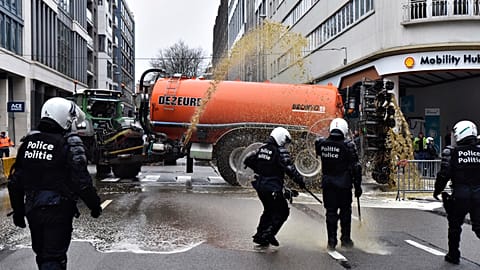The price farmers are paying to grow their crops and feed their animals has been one of the many reasons for recent protests.
British farmers have paid an additional £1.45 billion (€1.7 billion) for fertiliser since Russia’s invasion of Ukraine.
A new analysis from the UK’s Energy and Climate Intelligence Unit (ECIU) found that prices have soared, leading to billions more in costs and leaving farmers increasingly turning to nature-based solutions instead.
British farmers spent around £1.42 billion (€1.66 billion) on fertiliser in 2022 and £964 million (€1.1 billion) in 2023, according to the ECIU. Compared to the £470 million (€550 million) they spent in 2020 - the last normal year before prices soared - the organisation estimates that they have paid over 2.5 times more since February 2022 than they would have if costs had stayed stable.
Though prices have come down from the peak they remain high and the ECIU says, if they stay that way in 2024, it would mean an additional £285 million (€334 million) spent this year - 60 per cent more than they would have spent in 2020.
“Farmer protests are in the news, and one of the commonly cited reasons is the price they are having to pay to grow their crops and feed their animals,” says Tom Lancaster, land analyst at ECIU.
“Farmers have been paying a ‘gas price penalty’ on fertilisers, and bad news is that seems set to continue into 2024.”
Why are fertiliser prices so high?
The price of fertiliser spiralled upwards leading up to and after Russia’s invasion of Ukraine two years ago. It hit unprecedented highs in the summer of 2022 when prices almost quadrupled compared to the average in 2020.
Costs are closely tied to gas prices as making artificial fertilisers relies on the use of natural gas. Manufacturing nitrogen-based fertilisers requires nitrogen from the air to be mixed with hydrogen from natural gas at high temperatures and pressure to create ammonia.
A combination of sanctions, plans to reduce reliance on Russian supplies and overall shortages have increased natural gas prices over the last few years. And analysts have warned that they are projected to stay high for the next decade.
The UK is already starting to see the consequences of this with high gas prices cited as the main reason for the closure of the UK’s biggest ammonia plant in Billingham last year.
“The gas price crisis has revealed that a lot of UK production is dependent on imported fertilisers and pesticides,” says Colin Chappell, a farmer from Lincolnshire.
With high fertiliser costs here to stay, there is growing pressure on farmers’ finances and ramifications for consumers from food price inflation.
What are the alternatives to chemical fertilisers?
Farmers are considering natural solutions to insulate themselves from high costs and interruptions in supplies.
New schemes from the Department for Environment, Food and Rural Affairs (Defra) in England offer farmers payments for methods like cover crops and herbal leys that help to naturally build the health and fertility of the soil. These could also reduce farmers' reliance on expensive chemical fertilisers, replacing volatile imported nutrients.
Farming with nature, Chappell says, can give farmers independence, increasing the resilience of food production and building food security.
“With price pressures mounting, it doesn’t make sense for me to keep handing so much money over to big fertiliser companies when I can get paid to achieve more sustainable crop nutrition through these new schemes.”
As a bonus, many of these methods of naturally improving soil health are also some of the most effective ways of absorbing carbon and reducing river pollution and may also benefit wildlife like birds and pollinators.


















